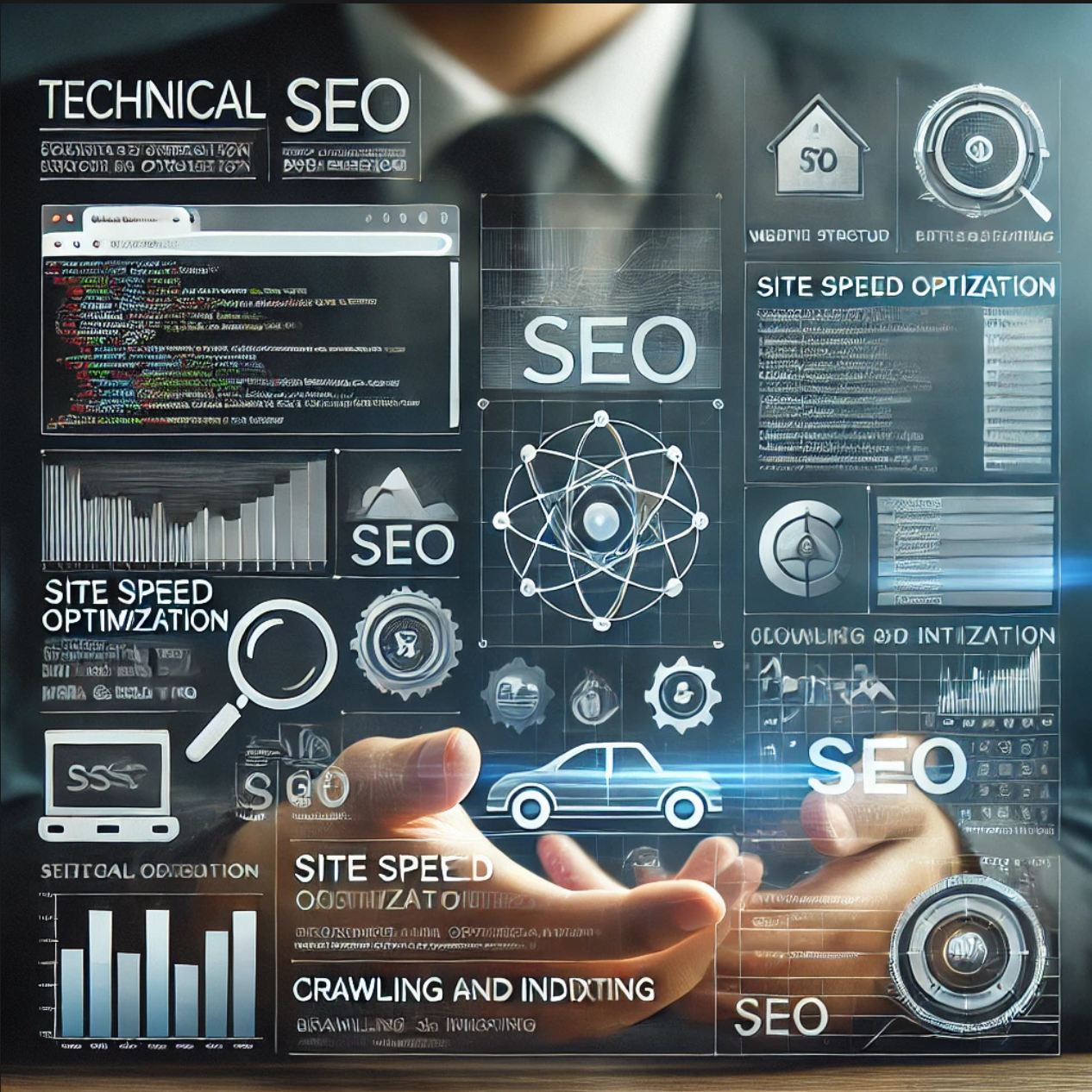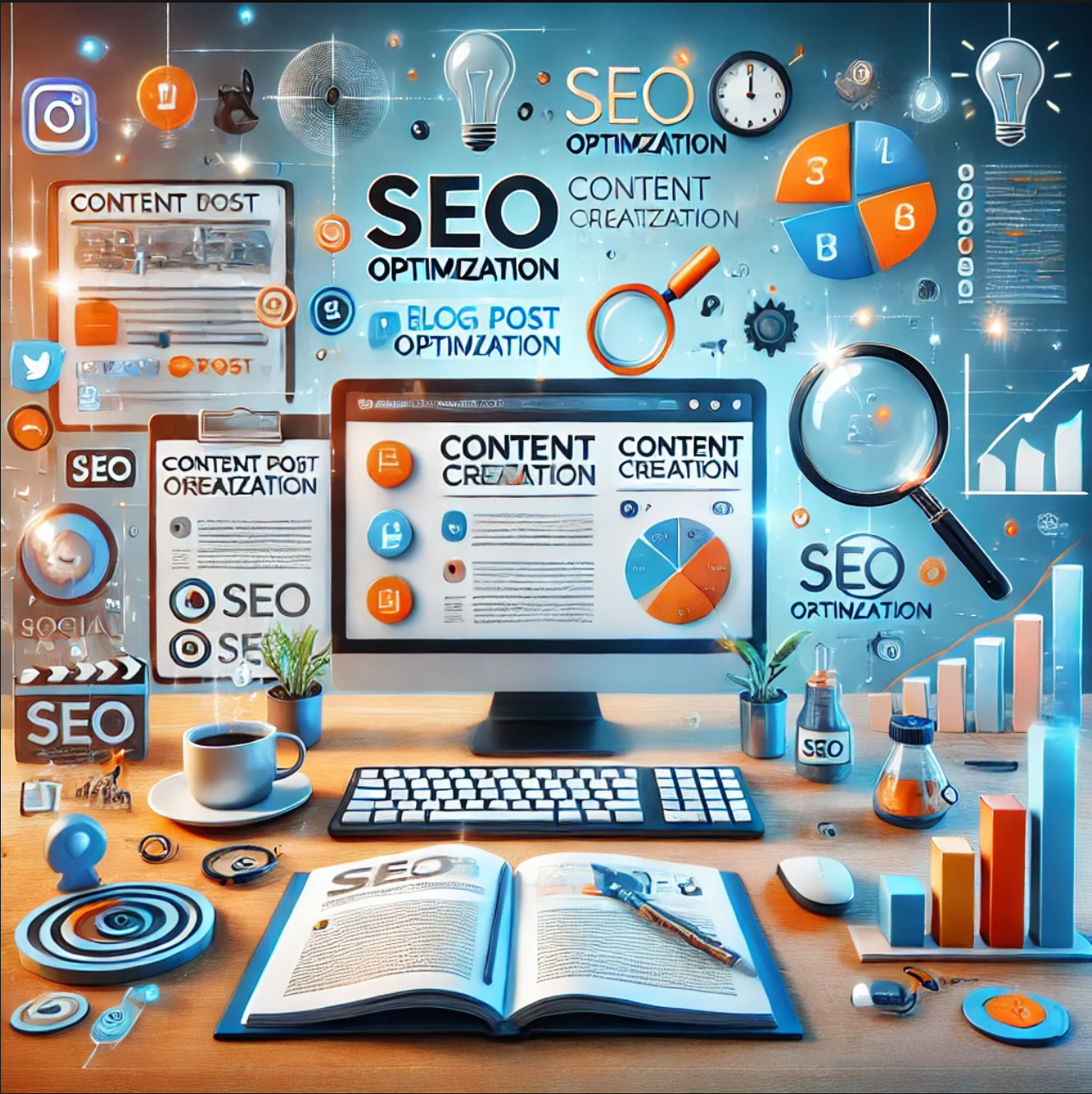
SEO Services Proven Results First Page Of Google
SEO Services Proven Results First Page Of Google
SEO Services That Get Results
Make it stand out.
What are the different types of S.E.O. services?
1. On-Page SEO
(On-page SEO refers to everything you do on your website to help search engines understand it better.)
2. Off-Page SEO
(Off-page SEO focuses on external factors, like backlinks, that affect how your site is ranked.)
3. Technical SEO
(Technical SEO addresses the backend structure of your website to ensure it's easy for search engines to crawl and index.)
4. Local SEO
Local SEO is crucial for businesses that target specific geographic areas. It's about optimizing your website and online presence to show up in local search results, helping your business get noticed by customers nearby.
Key aspects of Local SEO:
Google My Business (GMB): Creating and optimizing your GMB listing is essential for local SEO. It helps your business show up in local search results and on Google Maps.
Add accurate business info like address, hours, phone number, and website.
Upload photos and respond to reviews to build trust and engagement.
Local Keywords: Use location-specific keywords in your content and metadata (e.g., "best coffee shop in Austin" or "affordable plumber in Chicago").
NAP Consistency: NAP stands for Name, Address, and Phone number. It's crucial that this information is consistent across all online platforms, including your website, directories, and social media.
Local Listings & Directories: Get listed on local directories like Yelp, Yellow Pages, and other local business sites to boost your visibility in local searches.
Local Reviews: Encouraging happy customers to leave positive reviews on platforms like Google, Yelp, and Facebook can significantly impact your local rankings. Reviews help boost trust and improve local visibility.
Localized Content: Write content specific to your local area. This could be blog posts about local events, news, or topics relevant to your target location.
Why Local SEO Matters: Local searches often lead to direct action. For example, someone searching for “pizza near me” is likely to want to place an order or visit the restaurant immediately. By optimizing for local SEO, you can capture this demand and drive more foot traffic or phone calls to your business.
5. Paid SEO (Paid Search Advertising)
Paid SEO, or Paid Search Advertising, typically refers to Google Ads (formerly known as Google AdWords) or other paid search platforms like Bing Ads. Unlike organic SEO, which relies on unpaid tactics to rank higher, paid SEO involves paying for ad space to appear at the top or bottom of search engine results pages (SERPs).
Key aspects of Paid SEO (PPC - Pay-Per-Click):
Google Ads: This is the most popular form of paid search advertising. With Google Ads, you bid on specific keywords. Your ads will appear at the top of the search results when users search for those keywords.
Search Ads: These are the text-based ads you see above the organic search results.
Display Ads: These appear on websites across the Google Display Network, which includes millions of sites, apps, and videos.
Bing Ads: While Google dominates the search engine market, Bing also has a paid search platform that can be valuable, especially for targeting a slightly different demographic.
Keyword Targeting: Just like with SEO, paid SEO relies on choosing the right keywords. However, with paid search, you bid on keywords and pay for each click your ad receives.
Ad Extensions: Google allows you to add extra information to your ads, like location, phone number, site links, etc. These help make your ad more engaging and increase click-through rates (CTR).
Landing Pages: When users click on your ad, they are directed to a landing page. This page needs to be highly relevant to the ad to convert visitors into customers (e.g., a specific product page if you’re advertising a product).
Ad Copy: Crafting compelling ad copy is key to getting clicks. Your ad text should clearly communicate what you're offering and include a strong call to action (CTA), like "Shop Now," "Learn More," or "Get a Free Quote."
Budget and Bidding: You'll need to set a budget for how much you're willing to spend on your ads. Google Ads works on a bidding system, meaning the more you bid, the more likely your ad will appear in a higher position.
Why Paid SEO (PPC) Matters: Paid search advertising allows you to quickly drive traffic to your website, often within minutes of launching your ad campaign. It’s a great way to boost visibility, especially for competitive keywords or when you're just starting and haven’t built up organic search authority yet.
Paid search also offers precise targeting, meaning you can tailor your ads based on factors like:
Location: Target people in specific regions or cities.
Device: Show ads to mobile users, desktop users, etc.
Time of Day: Set ads to show during specific hours when your target audience is more likely to search.
Paid SEO can be especially helpful for e-commerce sites or businesses that need immediate results. Unlike organic SEO, which can take months to show results, paid ads start driving traffic right away.
6. Content SEO
(Content SEO focuses on creating high-quality, optimized content for your audience. This is a key part of on-page SEO.)
7. Video SEO
(Optimizing video content on platforms like YouTube to improve rankings and visibility.)
8. Voice Search SEO
(Optimizing for voice-activated devices like Siri and Alexa, where queries tend to be more conversational and natural.)
Recap of Key Types of SEO:
On-Page SEO: Everything on your website to help search engines understand it.
Off-Page SEO: Actions outside your website (e.g., backlinks, social signals).
Technical SEO: The backend optimization of your website for better crawling and user experience.
Local SEO: Optimizing your online presence for location-based searches (critical for businesses with a physical location).
Paid SEO (PPC): Running paid ads to appear at the top of search results.
Content SEO: Creating content that’s optimized for both users and search engines.
Video SEO: Optimizing video content for platforms like YouTube and search engines.
Voice Search SEO: Optimizing for voice search queries and devices.
Final Thoughts: SEO is a combination of strategies and techniques that aim to make your website more visible in search engines. Whether you focus on organic methods (like on-page, off-page, and local SEO) or supplement your efforts with paid strategies (like PPC), the goal is always the same: attract more visitors and help your business grow.
Eazy Drive recommends a combination of both organic SEO and paid SEO (PPC) because using both strategies together can deliver optimal results for a business's online visibility and growth. Here's why combining organic and paid SEO is a smart approach:
Quick Results with Paid SEO & Long-Term Gains with Organic SEO
Paid SEO (PPC): Paid advertising campaigns, like Google Ads, deliver immediate results. As soon as your ads are live, they start appearing in the search results or on relevant websites, driving traffic to your site right away. This is especially valuable when you need to generate leads or sales quickly, or when you're launching a new product or service and want to attract attention right away.
Organic SEO: Organic SEO is a longer-term strategy. It involves optimizing your website to rank higher in search engines naturally (without paying for ads). While it takes time (weeks or even months) to see significant results, organic SEO is sustainable and can continue to generate traffic without ongoing ad spend once you’ve built up authority.
If you're relying solely on paid ads, you're essentially paying for traffic, which stops as soon as you stop paying. On the other hand, organic SEO can help you establish a steady flow of free, sustainable traffic. By combining both, you can:
Drive immediate traffic (Paid) while building long-term authority (Organic).
Maintain visibility even after your paid ads stop (thanks to organic rankings).
Increased Visibility and Brand Exposure
Organic Results: Organic search results tend to get more trust from users because they are earned (based on relevance, quality, and authority) rather than paid for. Ranking well in organic search can build long-term brand credibility.
Paid Ads: Paid ads appear at the very top of search results, which means you can occupy valuable real estate on the search engine results page (SERP). Having your business appear in both the paid and organic sections of the results increases your visibility and credibility.
When people see your website both in paid ads and organic search results, it reinforces your brand and makes you appear more authoritative. Users may be more likely to click on your website when they see it in both places.
Higher Click-Through Rate (CTR): Studies have shown that websites appearing in both organic and paid results tend to have higher click-through rates compared to those relying on just one or the other.
Competitive Advantage
Paid SEO (PPC): In highly competitive industries, it can be tough to rank organically for popular keywords. By using paid search ads, you can target those keywords immediately, even if you're still working on improving your organic rankings.
Organic SEO: Once you've built up your website’s authority through organic SEO, you can rank for more competitive, high-volume keywords without needing to spend money on ads.
Why Combine Both?
In industries with tough competition, combining both strategies allows you to secure your place in the search results, even if your organic rankings haven’t reached their full potential yet.
While you’re working to build long-term organic rankings, you can gain immediate exposure through paid ads.
More Comprehensive Customer Journey
Paid Ads: Paid ads are great for targeting specific audience segments and can be highly tailored to match the search intent of different types of customers. For example, you can run ads for people who are at the awareness stage, the consideration stage, or the purchase stage.
Organic SEO: Organic content often focuses on providing helpful, informational content, which can help nurture users through the consideration and decision stages.
Why Combine Both?
By using both organic and paid SEO, you can create a full-funnel marketing approach. Paid ads can bring customers to your site early in the buying process, while organic content can help keep them engaged and informed as they move toward making a purchase.
For example, a customer might first discover your brand through a paid ad but return later to read a detailed blog post you’ve ranked for organically.
Cost Efficiency in the Long Run
Paid SEO (PPC): While paid ads are effective in the short term, they require ongoing investment. The more competitive the keywords, the more you’ll need to spend on your ad campaigns.
Organic SEO: Organic traffic, once established, can provide a continuous flow of visitors without ongoing costs (except for maintenance and content updates).
Why Combine Both?
You can rely on paid SEO for immediate returns while you build up organic traffic over time. Once you’ve optimized your site and built authority, your reliance on paid search can decrease, making your overall marketing strategy more cost-efficient in the long run.
With both strategies, you’ll also be able to test and adjust your campaigns regularly, so you can maximize your budget while still driving quality traffic.
Summary: Why Combine Organic and Paid SEO?
Eazy Drive (and many other experts) recommend combining both organic SEO and paid SEO because:
Speed and Sustainability: Paid ads deliver immediate results, while organic SEO builds long-term, sustainable traffic.
Increased Visibility: Appearing in both paid and organic search results reinforces your brand and boosts click-through rates.
Data-Driven Strategy: Paid ads help you quickly gather data on keywords and performance, which can improve your organic SEO strategy.
Competitive Edge: Paid SEO allows you to secure top positions for competitive keywords, while organic SEO helps you build authority and rank over time.
Cost Efficiency: Paid search offers immediate returns, while organic traffic becomes more cost-effective as it grows.
By using both, businesses can maximize their online presence, increase traffic, and improve their return on investment (ROI). It’s a way to ensure that you're covering both the short-term and long-term aspects of search engine visibility.
If you have any other questions or need more specific advice on implementing both strategies, feel free to ask!
Organic SEO Tools Used By Eazy Drive Marketing
These tools primarily focus on improving your website's visibility and rankings through organic search efforts.
Google Search Console
What it Does: Provides detailed insights into how your website is performing in Google's search results.
Key Features:
Performance Reports: Track clicks, impressions, CTR (Click-Through Rate), and average position for your site’s keywords.
Index Coverage: Monitor which pages are indexed and if there are any errors preventing indexing.
Sitemaps: Submit your website’s XML sitemap to Google to help search engines crawl your site.
Mobile Usability: Check if your site is mobile-friendly and identify issues.
Core Web Vitals: Understand how your site performs in terms of loading speed, interactivity, and stability.
Search Enhancements: Implement structured data and other search enhancements.
Google Analytics
What it Does: Tracks user behavior on your website, helping you understand how visitors interact with your content.
Key Features:
Traffic Data: See where your visitors are coming from (e.g., search engines, social media, direct traffic).
Behavior Flow: Track user behavior on your site, including which pages they visit and how long they stay.
Audience Insights: Understand your audience's demographics, interests, and devices.
Goals and Conversions: Set up goals (e.g., form submissions, sales) and track conversion rates.
Google Keyword Planner
What it Does: Helps you discover keyword ideas and analyze their search volume, competition, and cost-per-click (CPC) to inform your SEO strategy.
Key Features:
Keyword Research: Find new keywords for your website based on phrases and topics related to your business.
Search Volume: Get an estimate of the average monthly searches for specific keywords.
Competition Level: Evaluate how competitive a keyword is in Google Ads, which can also help in organic ranking strategy.
Google Trends
What it Does: Analyzes the popularity of top search queries across various regions and languages.
Key Features:
Trend Analysis: Identify trending topics and search terms over time.
Regional Interest: See how interest in specific keywords varies by location.
Compare Keywords: Compare the search volume of multiple keywords over time.
Google Page Speed Insights
What it Does: Provides suggestions for improving the performance of your website in terms of speed, which is a ranking factor in Google’s algorithm.
Key Features:
Performance Score: See how your site scores on both mobile and desktop devices.
Core Web Vitals: Check your site’s loading speed, interactivity, and stability.
Suggestions: Receive actionable recommendations to improve your site’s performance.
Google Mobile-Friendly Test
What it Does: Checks if your website is optimized for mobile devices, which is critical for both SEO rankings and user experience.
Key Features:
Mobile Usability: See if your website passes Google's mobile-friendly tests.
Improvement Suggestions: Get recommendations for making your site more mobile-friendly.
Google Rich Results Test
What it Does: Helps you check whether your pages are eligible for rich results (e.g., featured snippets, knowledge panels).
Key Features:
Structured Data Validation: Check if your page’s structured data is correctly implemented.
Rich Result Previews: See how your content might appear in the SERPs with rich snippets (e.g., star ratings, prices).
Google Discover
What it Does: A personalized content feed that delivers relevant, non-search-based traffic to your site via Google’s mobile app.
Key Features:
Content Optimization: Optimize content for a high chance of appearing in Google Discover.
Audience Insights: Analyze the type of content that performs well in Discover.
Google Data Studio
What it Does: Allows you to create custom reports and dashboards by integrating data from various Google tools like Analytics, Search Console, and Ads.
Key Features:
Custom Reporting: Visualize data from Google Search Console and Google Analytics.
Collaboration: Share and collaborate on reports with team members.
Paid SEO Tools (Google Ads-Related)
These tools are part of Google’s paid advertising ecosystem, designed to improve visibility and targeting through paid search campaigns.
Google Ads (Paid)
What it Does: Google’s main paid advertising platform, where you can run pay-per-click (PPC) campaigns.
Key Features:
Ad Campaign Management: Create and manage paid campaigns targeting specific keywords.
Bid Management: Set budgets and bid amounts for specific keywords.
Ad Extensions: Add additional information to your ads, such as phone numbers, location, and links.
Keyword Insights: Use Keyword Planner to research keywords and their performance for PPC.
Google Display Network (Paid)
What it Does: Allows you to place visual ads (banners, videos) on a wide variety of websites across the internet, not just search results.
Key Features:
Audience Targeting: Target specific groups based on interests, demographics, and behaviors.
Visual Ads: Create and place image or video ads to reach users across millions of websites.
Google Shopping (Paid)
What it Does: Allows e-commerce businesses to create ads that showcase their products directly in search results and Google Shopping.
Key Features:
Product Listing Ads: Display product images, pricing, and store name directly in search results.
Merchant Center: Manage your product feed and optimize how your products appear in Google Shopping.
Google Tag Manager (Free, but may involve costs for third-party tools)
What it Does: A tool that helps you manage and deploy marketing tags (snippets of code) on your website without needing to update the website code.
Key Features:
Tag Management: Easily deploy Google Analytics, Google Ads, and other tags to your site.
Event Tracking: Set up custom events to track interactions like button clicks, form submissions, etc.
Summary: Paid vs Organic Google SEO Tools
Organic Tools: These tools (like Google Search Console, Google Analytics, and Google Keyword Planner) are primarily focused on improving the free (organic) visibility of your website in Google search results. They help you analyze traffic, improve content, track user behavior, and optimize your website's performance.
Paid Tools: Tools like Google Ads and Google Display Network are for running paid campaigns. They help you target specific audiences with paid search ads, display ads, and product listings to gain visibility and drive immediate traffic to your site.
By using both organic SEO tools and paid SEO tools, you can create a comprehensive search marketing strategy that enhances both your immediate visibility (through ads) and long-term sustainability (through organic rankings).
How long does it take to get SEO going?
SEO is like planting a garden. When you start, you prepare the soil (your website) and plant seeds (keywords, content, and backlinks). It takes time for these seeds to grow. Typically, you’ll start seeing small results in 3 to 6 months, but it can take 6 to 12 months or more to see significant progress, especially if you’re targeting competitive industries or keywords.
Why does it take so long? Search engines, like Google, need time to “trust” your site. They check things like how helpful your content is, how often people visit your site, and whether other websites link to yours. Over time, this trust builds, and your website starts ranking higher.
Why balance paid and organic SEO? recommended*
Think of paid and organic SEO as two teammates:
Paid SEO (like Google Ads): This is the sprinter. It gets you immediate traffic and visibility, but it stops working the moment you stop paying. It’s great for quick wins, like promoting a sale or getting people to visit your website while you’re building your organic presence.
Organic SEO: This is the marathon runner. It takes longer to build up, but once it’s strong, it can bring consistent traffic without ongoing costs. It’s ideal for long-term growth and sustainability.
By combining both:
Paid SEO brings people to your site immediately while organic SEO takes time to grow.
Paid traffic helps you test which keywords and pages work best, so you can optimize your organic strategy.
Together, they create a steady stream of visitors, both now and in the future.
The long-term benefits of SEO are transformative, offering businesses the potential to generate substantial revenue through sustained, organic traffic growth. By ranking high on search engines for targeted keywords, businesses attract customers actively searching for their products or services, often leading to significant revenue. For example, a local company investing in SEO might start generating 1,000 organic visitors per month within a year. If 5% of these visitors convert into paying customers and spend an average of $50 each, that’s $2,500 in monthly revenue—or $30,000 annually—from organic traffic alone. Scaling up, an e-commerce brand ranking for high-traffic keywords could see 100,000 visitors per month. With a modest 3% conversion rate and an average order value of $100, that’s $300,000 in monthly sales or $3.6 million annually. Over time, as SEO efforts compound, acquisition costs decrease, and rankings stabilize, businesses can significantly outpace competitors relying on short-term tactics. This demonstrates how a well-executed, long-term SEO strategy isn’t just about visibility but also about driving substantial, scalable profits.
























